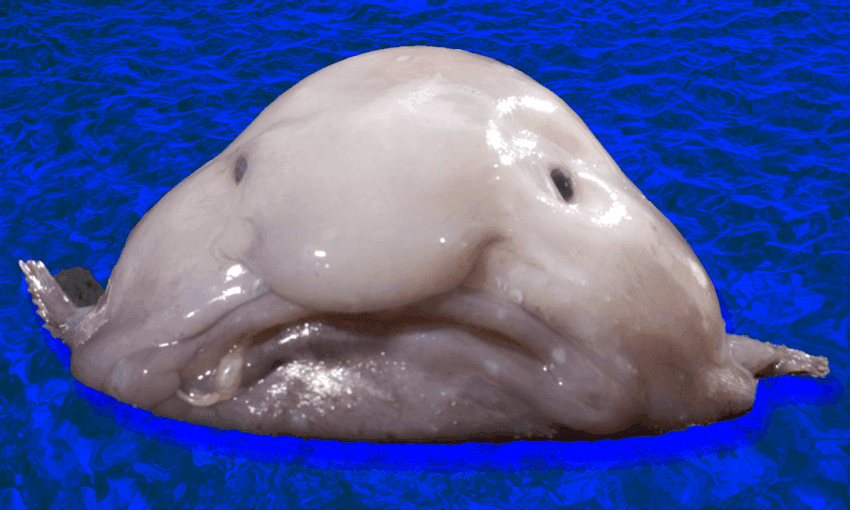In 2003, a crew member on a New Zealand research vessel snapped a photo of a funny-looking fish. This is the story of how ‘Mr Blobby’ became a deep-sea icon.
With its slimy pink skin, bulbous nose and downturned mouth, Mr Blobby is one of the world’s most famous fish.
The blobfish first began gracing our computer screens in the early 2010s, as a vintage image macro meme (“Go Home Evolution, You’re Drunk”).
Since then, its saggy pink form and relatable resting grumpy face has inspired soft toys, comics and songs. In 2019, budding fashionista North West stepped out wearing blobfish slippers.
You probably recognise the face. But what you may not realise is that this viral fish was a New Zealander, hauled up from the depths of the Norfolk Ridge, north-west of mainland Aotearoa.
It has been 20 years since the iconic image was snapped onboard Niwa’s research vessel, Tangaroa, during a joint Australia-New Zealand expedition to the abyssal plains and seamounts off the northwest tip of the North Island.
The team worked 24 hours a day (split into two shifts) to catalogue the treasure trove of flora and fauna hauled up from the deep during research trawls. “It was all hands on deck literally, in our steel cap boots and hard hats and gear to get all the specimens to the sorting lab,” remembers Kerryn Parkinson, ichthyologist at the Australian Museum.
Back in 2003, Parkinson was still a junior researcher, and her job was to photograph “anything that came up that was taxonomically uncertain, rare, or something that we actually didn’t know what it was.”
That included one baby-pink goo-ball of a fish – which initially didn’t elicit much of a reaction. “There was no big hoo-ha made. It was a fish,” says Parkinson. Practically everything being sorted was weird and wonderful, including gulper eels, coffinfish and devilfish. The blobfish was just one curiosity among many hoisted from 1300m below.
Parkinson photographed it in the standard fashion for fish specimens: with the head pointing to the left and tail to the right, alongside a colour chart, scale bar and registration number.
“I was about to return it to the sorting lab to be preserved, and I thought it just looked very funny. So I took a photo, front-on. Then we kept going,” says Parkinson. The team on duty joked that it looked like a balloon, and nicknamed it Mr Blobby (unrelated, Parkinson says, to the famous 90s British TV character).
The specimens gathered during the voyage were divvied up among the participating researchers, based on their expertise and specialities. The blobfish ended up preserved in a jar in the collection of the Australian Museum in Sydney.
It wasn’t until some seven years later that blobfish mania began. Parkinson still has no idea what sparked its sudden popularity, but figures the photo she took must’ve been discovered online. “The image just captured people’s imagination,” she says. In 2010, Australian TV panel show The Gruen Transfer latched onto the blobfish, labelling it “one of God’s ugliest, laziest and most miserable creatures”.
In 2013, the blobfish won a World’s Ugliest Animal Competition, run by the UK-based Ugly Animal Preservation Society. Other finalists included the proboscis monkey, with a similarly bulbous nose, and the adorable kākāpō (an addition that surely calls the integrity of the competition into question).
Parkinson thinks the title is “quite unfair” – she doesn’t see the blobfish as ugly at all. But, she concedes, she does work in an environment where she gets to see lots of strange, otherworldly creatures. “My reaction is more, ‘How amazing is this animal that can adapt and live down at those depths?!’ People really see what’s on the surface. But the wonder outweighs the image.”
In fact, the iconic image doesn’t do the blobfish justice. In its natural habitat, the blobfish appears more streamlined and fish-like, without the droopy glob of a nose. Hundreds of metres below the ocean’s surface, the pressure is around 120 times higher – on the slow ascent to the surface, Mr Blobby’s body suffered decompression damage and took on the gelatinous appearance we’ve come to know and love.
To celebrate 20 years since Parkinson captured the memeable blobfish mugshot, staff at the Australian Museum held a morning tea complete with blobfish cupcakes. But after two decades in a pickling jar, Mr Blobby no longer looks like his famous portrait. He’s reverted to a form closer to his deep-sea self. “Preservation will very slightly shrink the specimen, so his external skin has tightened and it looks more like a tadpole shape,” says Parkinson.
Over the last two decades, the blobfish has become “a poster pin-up for discovering new things” and “all the stuff down there we still don’t know about”, Parkinson says.
We do know more about the blobfish family than we did 20 years ago. Advances in technology mean scientists can now capture video footage of the fish hanging out in the deep, dark depths. The deep-sea paparazzi has revealed that blobfish are ambush predators – lying in wait for a tasty mollusc morsel – and they also lay eggs and guard their nest. New fathead sculpin species have been identified, too, and future deep-sea voyages are likely to uncover more.
But when it comes to Mr Blobby, there’s still a lot we don’t know. The specimen looks similar to Psychrolutes microporos, a species that’s part of the fathead sculpin family. But sculpin specimens are rare, and we don’t have enough to compare and contrast physical features and make a definitive identification.
We don’t know how old Mr Blobby is, or whether Mr Blobby is in fact Mrs Blobby. Determining sex would require a dissection, and Parkinson says she’s “pretty sure no one’s going to dissect the world’s most famous fish.”
“There are still more questions than answers.”


